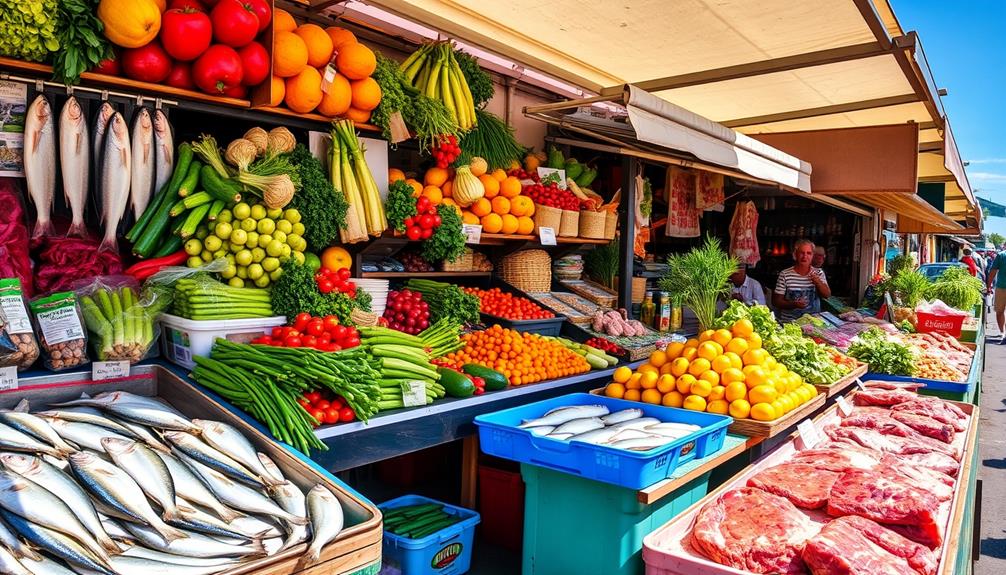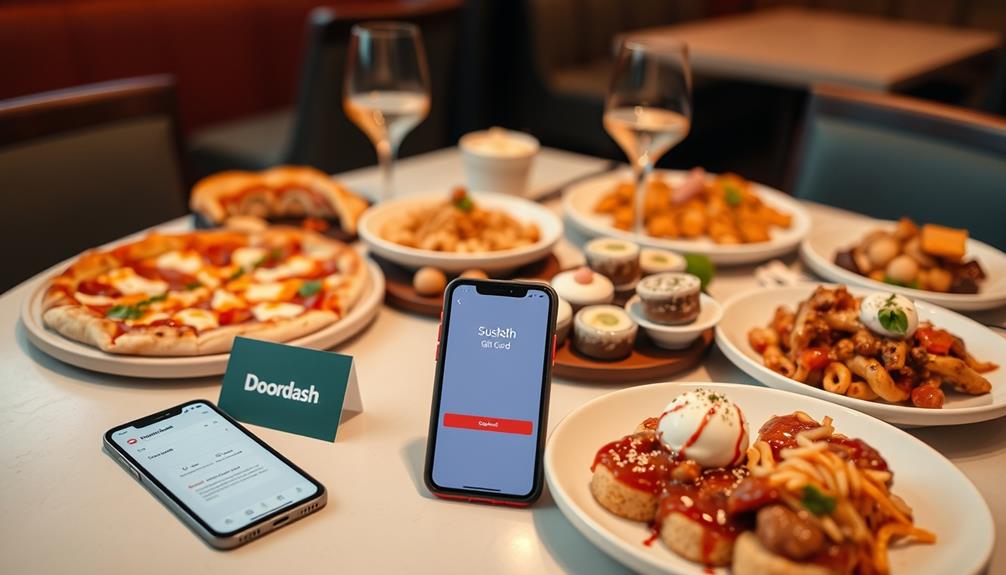Restaurants get their food from a mix of sources to guarantee quality and variety. They often partner with local farmers for fresh produce, meats, and dairy while relying on national distributors for broader selections. Specialty suppliers provide unique ingredients that can enhance menu offerings. Wholesalers help with bulk purchases, guaranteeing restaurants have enough stock on hand. This network allows for seasonal menus and supports local economies. However, the food supply chain faces challenges, such as unpredictable weather and transportation issues. Discover how these factors affect what ends up on your plate and the importance of building strong supplier relationships.
Key Takeaways
- Restaurants source food from local farmers, national suppliers, specialty suppliers, wholesalers, and direct-to-consumer suppliers to ensure diverse and quality ingredients.
- Local sourcing enhances freshness and flavor while supporting community economies and reducing carbon footprints through shorter transportation distances.
- National food suppliers offer competitive pricing and a broad range of products, making them vital for larger operations.
- Specialty food suppliers provide unique ingredients that cater to specific culinary needs and enhance menu offerings.
- Building strong relationships with suppliers ensures reliable delivery and access to high-quality ingredients, fostering long-term partnerships.
Understanding the Food Supply Chain
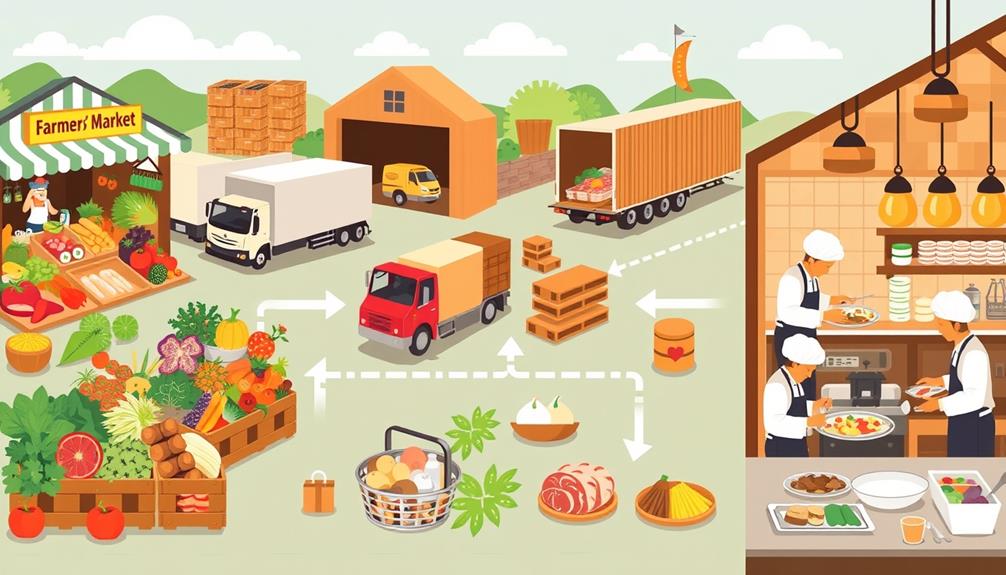
Have you ever wondered how the food on your plate gets there? The journey starts with farmers and growers producing raw materials like fruits, vegetables, grains, and livestock. These raw ingredients are the foundation of the food service industry.
Once harvested, they're processed and packaged for transportation. This is where restaurant suppliers come into play, ensuring these products reach the right places. In addition to the physical supply chain, understanding common financial terms associated with restaurant operations can provide insight into how restaurants manage their costs and pricing strategies.
After processing, food moves to distribution centers and wholesalers. Here, distributors manage the logistics, making sure everything arrives at restaurants efficiently and on time. They're essential in maintaining a steady supply, especially since fluctuations in weather can greatly impact crop yields.
When a drought or storm hits, it can pose real challenges for consistent food supply. Understanding the food supply chain helps you appreciate the complexity behind each meal.
It's not just about what's on your plate; it's about the network of farmers, processors, distributors, and wholesalers working together to deliver quality ingredients. So, next time you dine out, remember the intricate journey your food took to get there, thanks to dedicated restaurant suppliers and a robust food service system.
Key Players in Food Sourcing
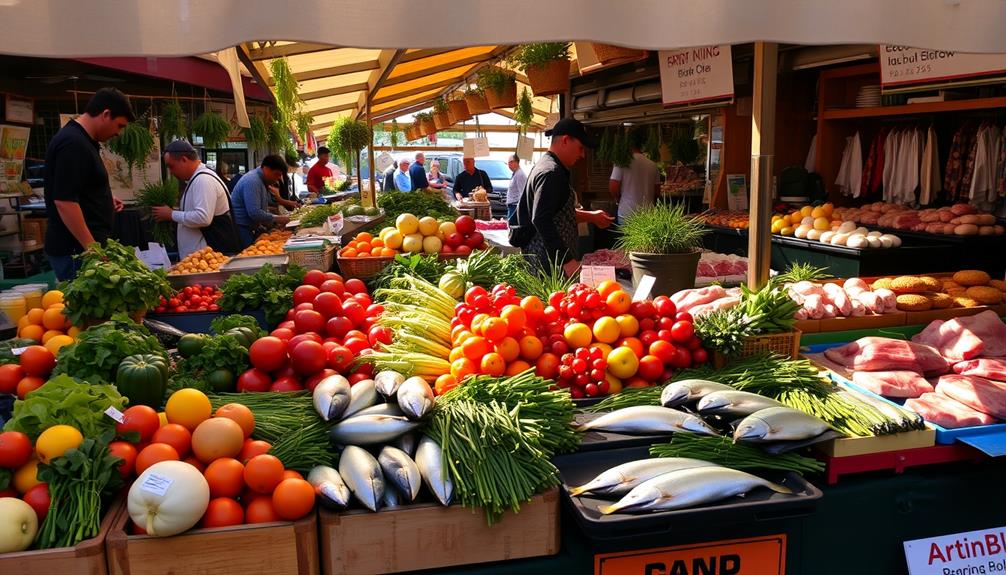
The food sourcing process is a collaborative effort that involves various key players contributing to the restaurant's menu. You'll find that restaurants source their food products from a diverse range of suppliers.
Local farmers provide fresh produce, meats, and dairy products, ensuring the quality and freshness of ingredients. For instance, utilizing local produce can also support sustainable practices, such as transforming your garden with composting techniques that enrich the soil.
On a larger scale, national food suppliers offer competitive pricing and a wide variety of products, catering to different cuisines and culinary needs.
Specialty food suppliers come into play by offering unique, hard-to-find ingredients that allow you to create distinctive dishes.
Wholesalers are essential in this chain, supplying bulk products to restaurants and ensuring consistent access to necessary ingredients.
Additionally, direct-to-consumer suppliers enable you to purchase fresh ingredients straight from the source, enhancing the quality and flavor of your dishes.
Challenges in Food Distribution
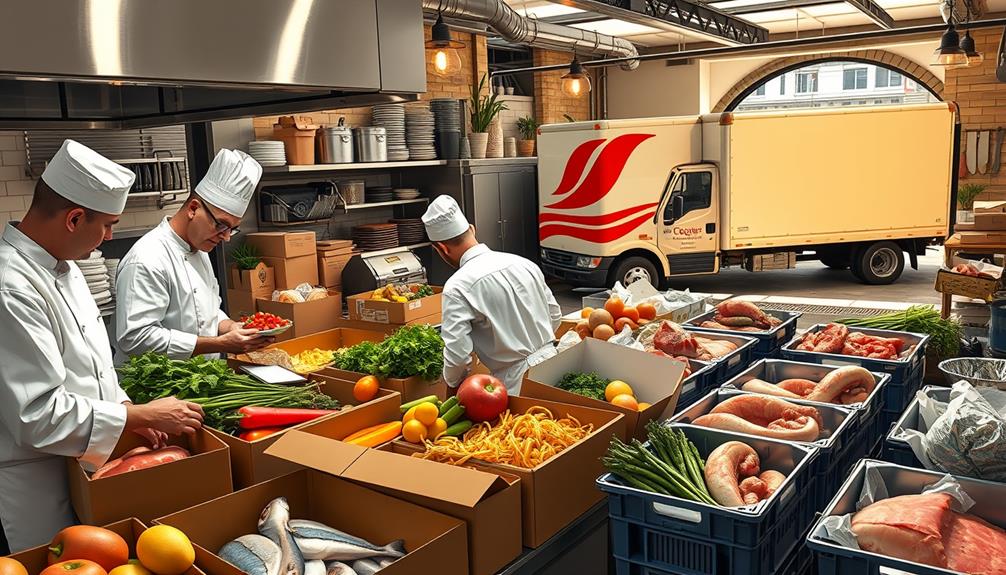
Food distribution presents several challenges that can greatly impact restaurant operations. You may not realize how unpredictable weather patterns can affect crop yields, leading to supply shortages that leave you scrambling for fresh produce. Transportation and logistics issues can delay deliveries, compromising the quality and freshness of your menu items.
Here's a snapshot of some common challenges in the food industry:
| Challenge | Impact on Restaurants |
|---|---|
| Unpredictable weather | Crop shortages and supply issues |
| Transportation delays | Risk of food spoilage and waste |
| Fluctuating raw material prices | Budget constraints and cost management |
| Quality inconsistencies | Limited menu options and customer dissatisfaction |
These challenges can create significant operational issues. You might find it tough to maintain consistency with restaurant suppliers, and any inconsistency in quality can impact your customer satisfaction. The complexity of the food supply chain, involving multiple stakeholders from farmers to processors to distributors, adds another layer of vulnerability. Understanding these challenges can help you better navigate the ever-changing landscape of food distribution.
Types of Food Suppliers
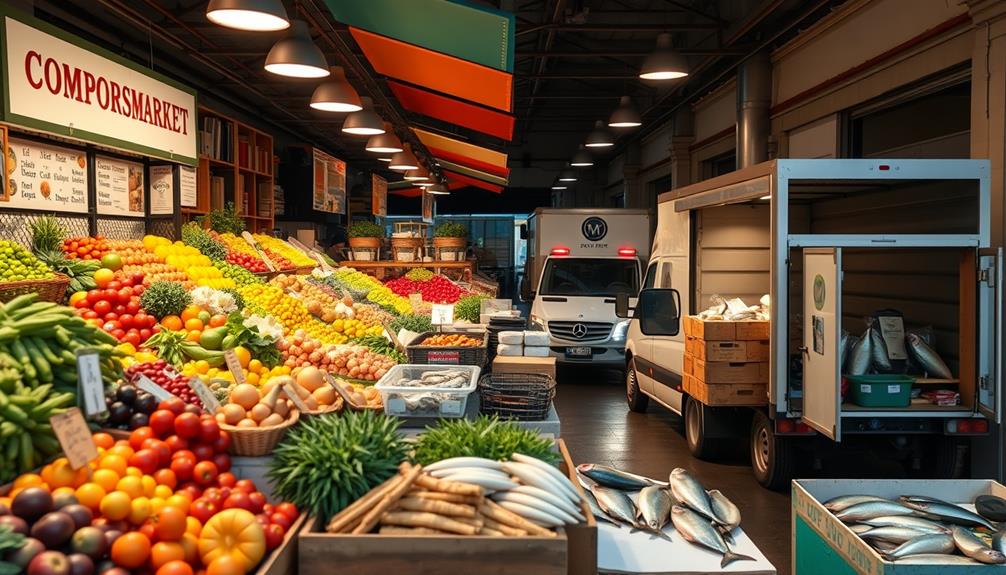
Steering through the challenges of food distribution requires a solid understanding of the types of suppliers available to restaurants. You have several options when it comes to food suppliers, each catering to different needs.
Local food suppliers focus on regionally sourced ingredients, ensuring freshness while supporting local economies. For instance, many chefs appreciate the quality of ingredients like butter basics, which can greatly enhance their dishes.
If you're looking for cost-effective choices, national food suppliers operate on a larger scale, offering a wide variety of products at competitive prices.
For unique culinary needs, specialty food suppliers provide hard-to-find ingredients that allow you to create distinctive dishes that set your restaurant apart. If you prioritize freshness and quality, consider direct-to-consumer suppliers, which enable you to purchase ingredients straight from producers. This method often guarantees the highest quality.
Lastly, wholesale suppliers can be a great option for larger operations, supplying bulk products that offer both convenience and cost savings.
Each type of restaurant supplier has its advantages, so understanding your specific needs will help you make informed decisions when stocking your kitchen. Ultimately, the right mix of suppliers can enhance your menu and improve your restaurant's overall efficiency.
Choosing the Right Supplier
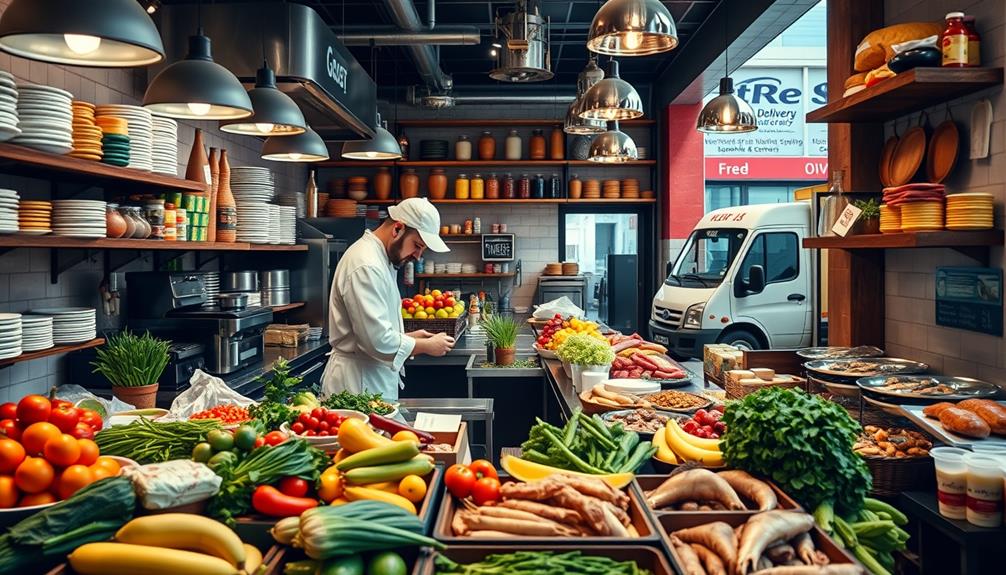
Choosing the right supplier can greatly impact your restaurant's success, especially when you consider factors like quality, pricing, and reliability. When you're on the hunt for a restaurant supplier, it's essential to evaluate their quality products and safety standards, much like how one would assess mechanic shops for fuel injection cleaning.
A supplier's reputation—shaped by positive word-of-mouth and proven reliability—should weigh heavily in your decision-making process.
Don't forget to assess pricing and payment terms, as these can greatly affect your bottom line. Think about delivery schedules too; a reliable supplier, such as US Foods, can streamline operations with thorough delivery services tailored to your restaurant's needs.
Flexibility is another important aspect. You want a supplier who can customize their offerings to support your unique culinary vision and menu development.
This adaptability not only guarantees you get the ingredients you need but also enhances your overall operational efficiency.
Importance of Local Sourcing
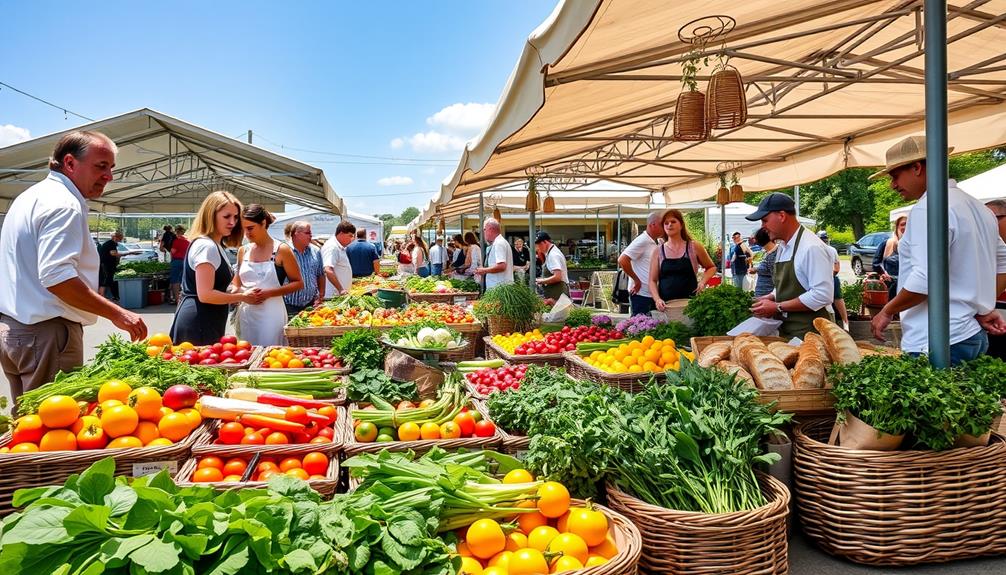
When you choose to eat at a restaurant that sources locally, you're not just enjoying fresher ingredients; you're also supporting your community's economy.
This commitment can greatly reduce transportation costs and carbon footprints, making dining out a more sustainable choice.
Additionally, just as homes with security systems deter threats, local sourcing can bolster the resilience of local farms and businesses against larger commercial competitors.
Plus, local sourcing often leads to unique menu options that highlight the best of what your region has to offer.
Freshness of Ingredients
The freshness of ingredients is essential for creating exceptional dishes, and local sourcing plays a key role in achieving that quality. By procuring ingredients from nearby farms, restaurants can guarantee that what's on your plate is at its peak freshness.
This approach not only enhances flavor but also boosts nutritional value, as produce harvested at the right moment tends to taste better. Embracing local sourcing aligns with the growing trend of sustainability in the culinary world, as many restaurants are opting for eco-friendly practices that complement their menu offerings.
Consider the benefits of local sourcing:
- Quick Turnaround: Ingredients can be delivered within hours of harvest, maintaining their quality.
- Enhanced Flavor: Fresh produce often has a superior taste compared to items that have traveled long distances.
- Sustainability: Reducing transportation distances lowers the overall carbon footprint, which is a key aspect of modern farmhouse decor trends.
- Seasonal Menus: Adapting to seasonal availability guarantees dishes are made from the freshest ingredients.
- Community Ties: Building relationships with local suppliers fosters a sense of community and trust.
Supporting Local Economies
Supporting local economies through food sourcing not only benefits restaurants but also invigorates the communities they serve. When you choose to purchase from regional farmers and food producers, you're directly supporting job creation in agriculture and related industries. This commitment to local sourcing leads to economic growth, which keeps your community thriving.
Additionally, embracing local ingredients can echo the traditions of Indigenous cultures, such as the rich heritage of the Hopi Tribe, creating a deeper connection to the land and its history.
By sourcing high-quality ingredients from local suppliers, you also enjoy the advantage of fresher produce, enhancing the quality of your dishes. This freshness translates into better flavors, which can considerably boost customer satisfaction. Plus, showcasing unique regional flavors gives your menu a distinct edge, attracting more diners enthusiastic to experience local culinary delights.
Furthermore, collaborating with local producers fosters a network of partnerships that strengthens community ties. It promotes shared values around sustainability and quality, making your restaurant a pillar of the local economy.
When you prioritize local sourcing, you're not just serving food; you're making a meaningful impact on your community. Supporting local economies isn't merely a business strategy—it's a commitment to the people and places that make your restaurant special.
Reducing Carbon Footprint
Sourcing food locally is a powerful way to reduce your restaurant's carbon footprint while promoting sustainability. By choosing to buy from nearby farms and producers, you greatly cut down on transportation distances, lowering greenhouse gas emissions linked to food delivery.
This approach not only supports local economies but also aligns with the growing demand for transparency in food sourcing, which is critical for consumer trust financial considerations for elderly care. Studies show that local food systems can reduce carbon emissions by up to 30% compared to traditional supply chains.
Here are some benefits of local sourcing:
- Reduced transportation emissions: Shorter distances mean less fuel consumption.
- Fresher ingredients: Local produce typically arrives quicker, enhancing flavor and quality.
- Lower food waste: Short supply chains help minimize spoilage and waste.
- Support for sustainable practices: Local farmers often prioritize environmental health and biodiversity.
- Community engagement: Building relationships with local suppliers fosters a circular economy.
Innovation in Food Supply
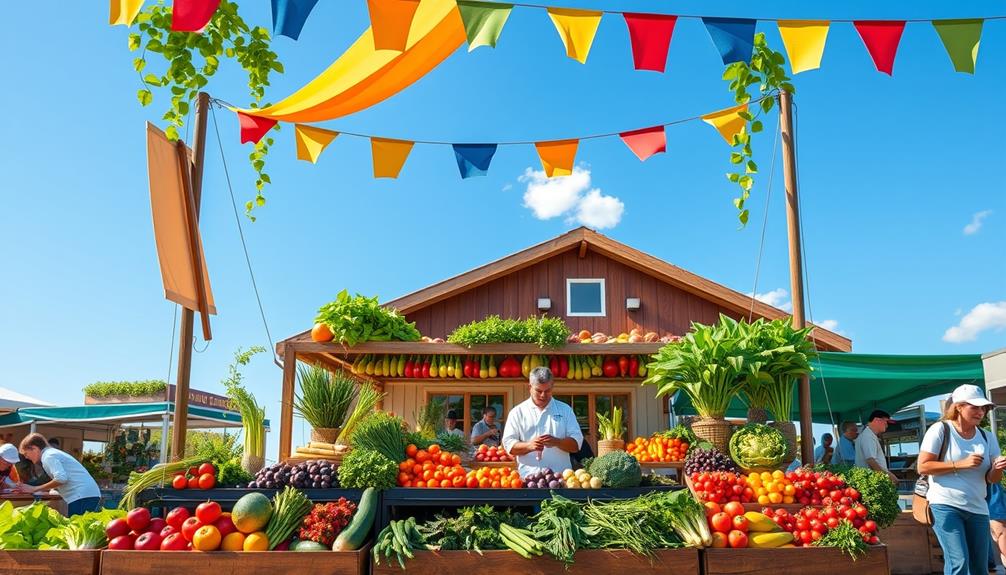
As restaurants endeavor to stay competitive, they're increasingly turning to innovative food supply solutions that enhance efficiency and quality. One major shift in the supply chain involves adopting new technologies like real-time analytics and integrated POS systems.
These advancements streamline operations, allowing you to track inventory and manage orders seamlessly, which is vital for improving content relevance and authority in today's market.
Suppliers are also focusing on sustainable practices, incorporating eco-friendly packaging and local sourcing to meet the rising consumer demand for environmentally responsible options.
This shift not only aligns with modern values but can also improve your restaurant's image in the community.
Moreover, the rise of specialty food suppliers has introduced unique, hard-to-find ingredients.
This allows you to craft distinctive dishes that cater to evolving culinary trends, setting your menu apart in the competitive restaurant industry.
Distributors like US Foods offer innovative food solutions that provide tailored products to meet your specific needs, ensuring freshness and quality across diverse cuisines.
In addition, advanced logistics and delivery systems enhance reliability and timeliness, essential for maintaining consistency in your restaurant operations.
Technology in Food Distribution
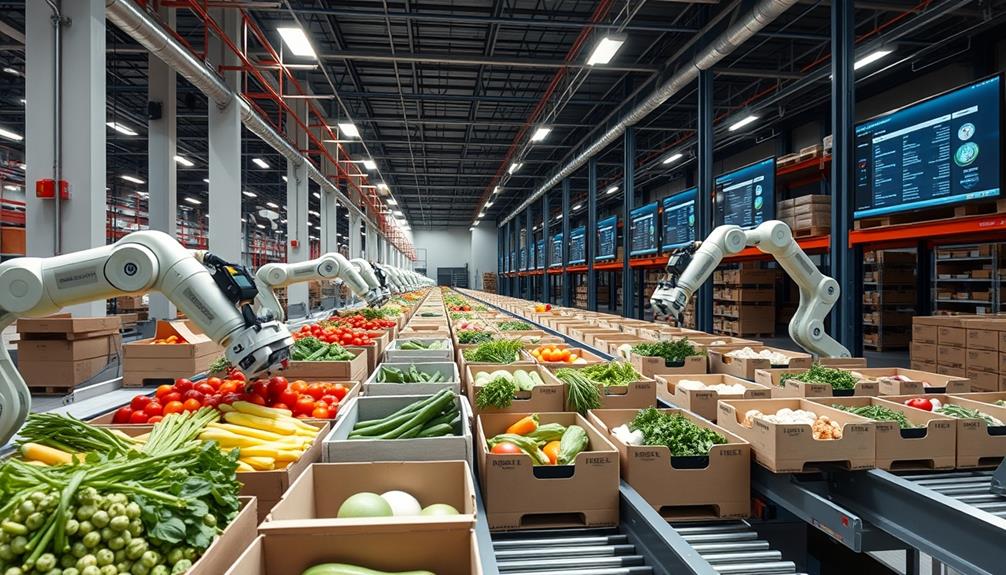
While many factors contribute to the efficiency of food distribution, technology plays a pivotal role in transforming how restaurants receive their supplies. With advancements in technology, you can streamline your restaurant operations, ensuring that you always have what you need when you need it.
Recent developments in AI discoveries indicate that artificial intelligence is revolutionizing various industries, including food distribution, by enhancing logistics and predicting supply chain disruptions.
Consider these key technological innovations:
- Real-time tracking systems that monitor inventory levels and delivery routes, reducing delays.
- Advanced Point of Sale (POS) systems, like Toast, that integrate with supply chains for better order management.
- Automation in warehouses with robotic picking systems that enhance accuracy and minimize errors.
- Cloud-based platforms that facilitate communication between suppliers and restaurants, enabling seamless ordering.
- Data analytics tools that predict demand trends, helping maintain ideal stock levels and reduce waste.
Building Supplier Relationships
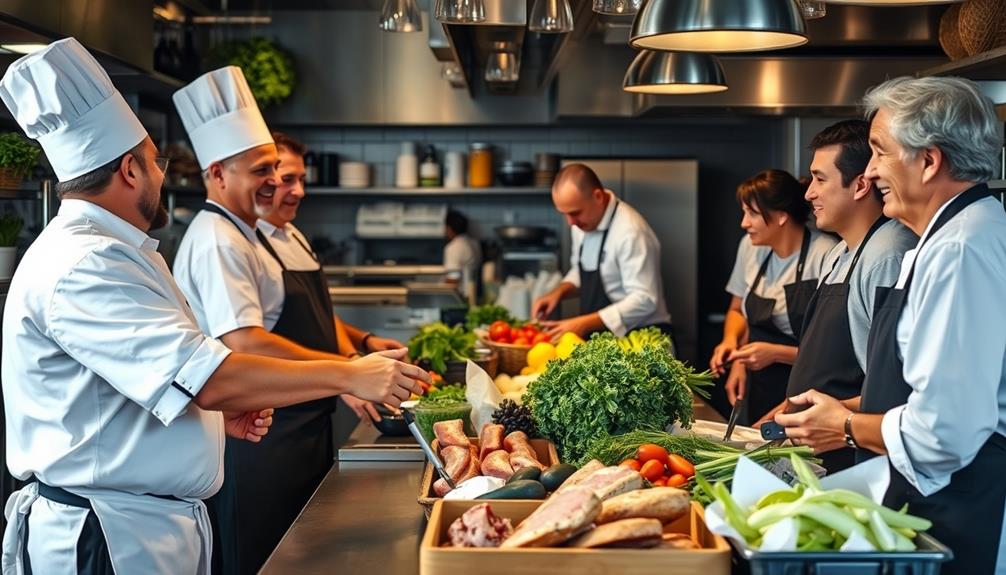
Strong supplier relationships are essential for any restaurant aiming to thrive in a competitive market. By focusing on building supplier relationships, you can secure high-quality ingredients and guarantee reliable delivery, which helps maintain consistent menu offerings and operational efficiency.
Open lines of communication foster transparency, enabling you to address issues quickly and collaborate on innovative product offerings. Engaging with local suppliers not only supports your community but also assures fresher ingredients, as products come from closer to your restaurant. This can greatly enhance your menu's appeal.
Long-term partnerships often lead to better pricing agreements and exclusive access to unique products, giving you a competitive edge. Regularly reviewing supplier performance is key to maintaining these strong relationships. Evaluating factors like delivery reliability and product quality allows you to adapt to changing needs and expectations.
Frequently Asked Questions
Where Do Restaurant Get Their Food Supplies From?
When you think about where restaurants get their food supplies, consider local farms for fresh ingredients, national distributors for variety, and specialty suppliers for unique items. Each source plays an essential role in culinary creativity.
Who Brings the Food at a Restaurant?
Ever wondered who brings the food to restaurants? Suppliers play that essential role, delivering everything from fresh produce to specialty items. You'll often see trucks unloading products, ensuring chefs have what they need to create delicious meals.
Who Is the Biggest Food Distributor?
When you think about the biggest food distributor, Sysco comes to mind. With over $78 billion in sales, they serve countless customers globally, offering a wide range of food products and essential services to enhance operations.
Can You Order Food From Any Supplier for Your Restaurant?
You can order food from various suppliers for your restaurant, but you should consider their reliability, compliance with health standards, and how well they meet your menu needs to guarantee consistent quality and timely deliveries. It’s also important to consider the cost and efficiency of each supplier to ensure that you are getting the best value for your money. Additionally, establishing strong communication channels with your suppliers will help avoid any misunderstandings and ensure smooth transactions. According to the definition of retail, the process of obtaining goods or services from suppliers is a critical aspect of running a successful restaurant business. Therefore, take the time to carefully evaluate and select the best suppliers for your restaurant’s needs.
Conclusion
Just like a chef carefully selects ingredients to craft a masterpiece, restaurants must navigate the intricate food supply chain to create their own culinary art. By choosing the right suppliers and fostering strong relationships, they can guarantee a fresh, diverse menu that delights customers. Embracing local sourcing and innovative practices is like planting a garden—nurturing the roots of their community while growing unique flavors. In the end, it's about creating a dining experience that tells a story of quality and care.
